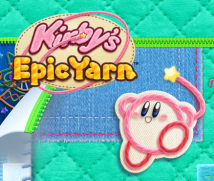4. Surprise, Fun and Warmth
Now let’s begin the second half of today’s discussion. I first met the four of you lined up here before me during my days at HAL Laboratory, so I don’t need you to introduce yourselves (laughs), but that doesn’t apply to people around the world, so first I’d like you to introduce yourselves and say what it is you do. Let’s start with you, Yamamoto-san.
I’m Yamamoto from HAL Laboratory. I’m in what we call the Character Producing Section. I’m in charge of things like the Kirby game world and overall production of development.
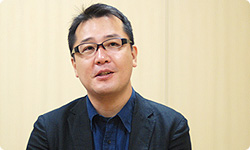
I’m Ishikawa from HAL Laboratory. I’m in charge of sound, so I make the music and sound effects.
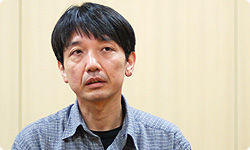
Ishikawa-san was central in making the music that everyone is familiar with for the original Kirby game, so you could say he’s the original creator of the Kirby sound.
Yes.
I’m Ando from HAL Laboratory, and I worked on sound, too. I usually work on making the background music and sound effects in video games.
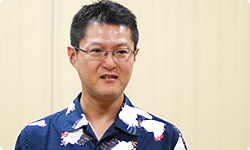
You were in charge of the sound for Kirby’s Adventure 7, the second game in the Kirby series, weren’t you? 7Kirby’s Adventure: An action game released for the NES system in September 1993. The second game in the Kirby series.
Yes, that’s right.
I’m Ikegami from HAL Laboratory. Originally, I worked on sound, but these days most of my work is as a manager.
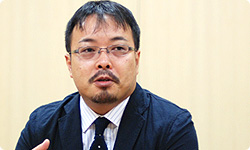
Thank you. Now… As Fluff’s Epic Yarn changed into Kirby’s Epic Yarn, what did you think as you became involved? Yamamoto-san, would you start us off? In addition to being in the Character Producing Section at HAL, you are also part of Warpstar, Inc. Could you explain what that company is?
Sure. When it came time to do the animation for Kirby: Right Back at Ya!8, it was decided that some kind of body was necessary for managing the character of Kirby, so in 2001 Nintendo and HAL Laboratory established Warpstar. 8Kirby: Right Back at Ya!: A cartoon series consisting of 100 episodes.
The cartoon is no longer being broadcast (in Japan), but Warpstar still exists for management of the character Kirby.
That’s right. HAL Laboratory’s Character Producing Section and Warpstar each oversaw different parts of Kirby’s Epic Yarn.
What was your first reaction when you heard about Kirby’s Epic Yarn?
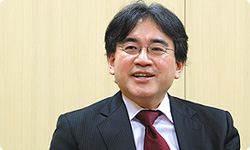
First, I had them show me the partially developed game without Kirby, and it was really well made. I was surprised we were going to take something that was already that far along and change it over to a Kirby game.
Did you think we were doing something awful?
The general world was pretty well established, so I thought some on the staff might be disappointed. That’s because I remembered when I was working on Pokémon Snap 9 in 1995. 9Pokémon Snap: A camera action game released for the Nintendo 64 system in September 2000.
Originally, Pokémon Snap for the Nintendo 64 wasn’t a Pokémon game, but rather a normal game in which you took photos, but the motivation for playing the game wasn’t clear. We wondered what players would enjoy taking pictures of, and later on we made a somewhat forced switch to taking pictures of Pokémon.
I was involved as a designer, so when characters other than the ones we had designed were used, I had a slightly negative reaction to it. But listening to your discussion with the developers from Good-Feel, I learned that they were lost early on in development, which was the same as with us before. That time, adopting the Pokémon world clarified what we should do and the direction we should head, and I came to like Pokémon, so I felt like that had saved us. So this time, while I could understand how everyone at Good-Feel felt, I started thinking about how I could get them to like Kirby.
But while you wanted them to like Kirby, given the Character Production Section’s mission of overseeing the intellectual property, you must have had to make some fairly strict demands.
Yes. In just a couple of years, it will be 20 years since Kirby first appeared. The series has developed in line with the thinking of a lot of different developers, so the world of the Kirby games is a difficult one to define concisely. Some things have to change with the times, and other things must stay the same. When we run into trouble, we think on the themes of surprise, fun and warmth.
How did things go with Kirby’s Epic Yarn?
When I first saw the visuals, the warmth was already there. All that was left was the surprise and fun. Yarn holds lots of potential for surprising mechanisms, and we talked earlier about how fun it is, so I think we were able to proceed with development rather smoothly.
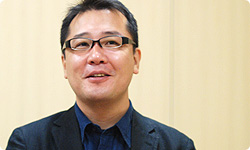
But the visuals are completely different from those of previous games in the Kirby series. What did you think of making Kirby out of yarn?
In the past, we first made Kirby out of pixels, and then polygons, and he’s even showed up in cell animation, so I actually wanted a new method of representing him. So when I heard the proposal for a world of yarn, I was thankful.
What did everyone else at HAL Laboratory think?
At first, I thought some within HAL might be against another company making a Kirby game, but I was worrying over nothing. Everyone said, “This is great,” so I think the reaction was really good.
Perhaps I should also ask the sound staff here what their first impression was. Ikegami-san, what did you think when you first saw the visuals?
When I first saw them, I thought they were perfect for Kirby. I think there’s a lot of potential for expanding this style to other series, like making a game called Mario’s Epic Yarn. That’s how well I thought the foundation had been laid, so I was really happy that from among all the characters available it was Kirby who was chosen.
You were glad the world of yarn idea hadn’t already been taken by another character.
Yeah! (laughs) But at the same time... I also thought, “Aw man!” Envy as a creator that we hadn’t thought of it first followed my initial joy.
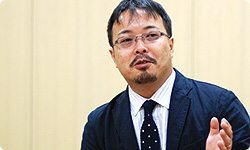
Right, that feeling of “Aw man!” is very important. Especially for people who work in the creative field.
As a creator, I was envious, but at the same time I was incredibly thankful to be involved with the project.
Ando-san, what did you think when you first saw it?
I, too, was extremely happy to be involved with it. The visuals really made an impact. The normal progress of graphics is toward greater realism. Most players have come to expect that, however, so when it comes to whether that direction can offer a surprise…
It’s not so surprising.
Right. But this world of yarn is surprising. That really impressed me. And the same goes for sound. As game consoles have developed, game music has become increasingly rich, but players expect that. So as with the graphics for Kirby’s Epic Yarn, I thought we needed to come up with surprising sounds that would surpass players’ expectations.
As a sound designer, you felt like the graphics had issued a challenge.
Yes. As we discussed earlier, one theme of the Kirby series is surprise, and that lies somewhere completely different than what players expect. Nonetheless, creating something completely unexpected would be surprising, but…
The players would also be a bit dumbfounded. (laughs)
Right. They would say, “What’s that got to do with Kirby?” It’s our job to find just the right surprise.
